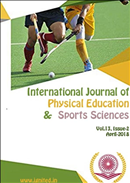Effect of Six Weeks Progressive Muscle Relaxation Technique on Resting Heart Rate of College Level Handball Players
Keywords:
Resting Heart RateAbstract
The purpose of the study was to investigate the effect of progressive muscle relaxation technique on reducing resting pulse rate of college level Handball players. Twenty subjects were randomly selected for the study (Experimental group=Ten, Control group=Ten) from B.P.Ed Students of LNIPE, NERC Guwahati. The variable selected for the study was resting heart rate. The criterion measure chosen for testing the hypothesis in this study was stop watch for testing resting heart rate. The training was carried out for a period of 6- weeks, three days a week in the evening for 30 minutes. By employing the Paired t-test method and for testing the hypothesis the level of significance was set at 0.05. By employing the Paired t-test method and for testing the hypothesis the level of significance was set at 0.05. The result of the study was significantly indicated that the varied Progressive muscle relaxation training program helped to reduce the resting heart rate of Handball Players of 18-22 age groups after 6- weeks training program.
Downloads
References
Retrieved from https://en.wikipedia.org/wiki/Progressive_muscle_relaxation
Kremer W. BBC News Magazine. The man who invented relaxation. November 4, 2015.
Charlotte Fritz et.al, (2010), The weekend matters: Relationships between stress recovery and affective experiences, Journal of Organizational Behavior.
Richardson & Rothstein, (2008), Effects of Occupational Stress Management Intervention Programs: A Meta-Analysis. Journal of Occupational Health Psychology 13(1): pp. 69-93.
Daniel K Brown, Jo L Barton, Jules Pretty, Valerie F Gladwell, (2014). Walks 4 Work: assessing the role of the natural environment in a workplace physical activity intervention. Scand J Work Environ Health.
Jensen MT, et al., (2013). Elevated resting heart rate, physical fitness and all-cause mortality: a 16-year follow-up in the Copenhagen Male Study. Heart; 99: pp. 882–887.






